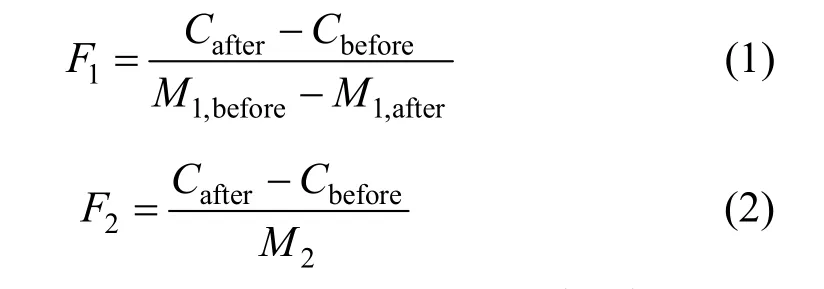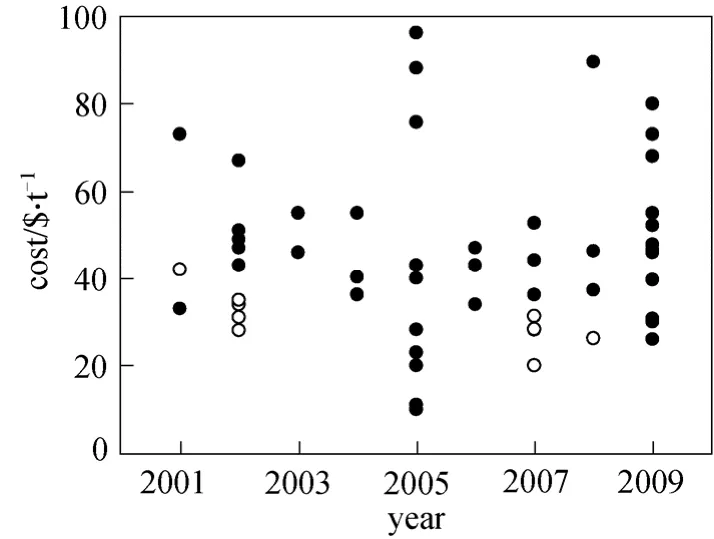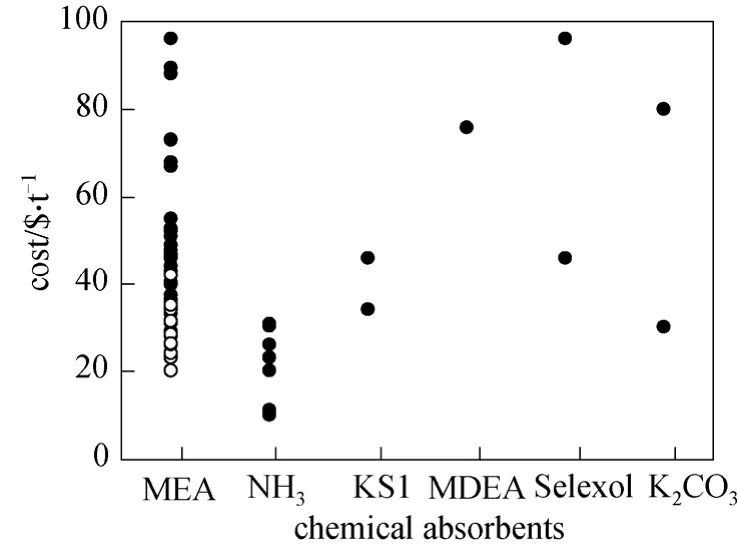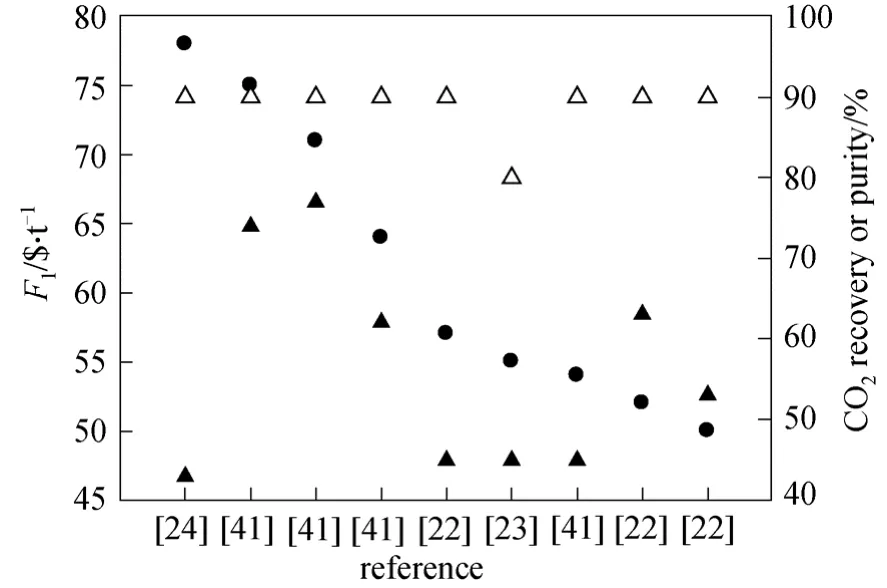Economic Comparison of Three Gas Separation Technologies for CO2 Capture from Power Plant Flue Gas*
2011-03-22YANGHongjun杨宏军FANShuanshi樊栓狮LANGXuemei郎雪梅WANGYanhong王燕鸿andNIEJianghua聂江华
YANG Hongjun (杨宏军), FAN Shuanshi (樊栓狮), LANG Xuemei (郎雪梅), WANG Yanhong(王燕鸿)** and NIE Jianghua (聂江华)
Key Laboratory of Enhanced Heat Transfer and Energy Conservation, Ministry of Education, South China University of Technology, Guangzhou 510640, China
1 INTRODUCTION
Large amounts of greenhouse gases releasing to the atmosphere in a short period can lead to global warming, among which CO2is the main contributor and accounts for about 60% of the greenhouse effect[1]. Coal-fired power plants are one of the major sources of the intensive emission of CO2and responsible for roughly 30% of the total emission of CO2[2]. According to the report of the U.S. energy information administration, 43% of the electricity is generated by coal-fired power plants all over the world before 2030[3], so more CO2will be released to the atmosphere and the climate change will be more serious. Hence,the emissions of greenhouse gases must be reduced greatly. One of the feasible methods to solve the dilemma is CO2capture and storage (CCS), including the separation of CO2from sources, transportation to a storage location, and long-term isolation from the atmosphere [3], in which CO2capture accounts for about 70%-80% of the total cost. There are three options for capture CO2from power plants, namely,pre-combustion capture, oxy-fuel combustion capture,and post-combustion capture [4-6], among which the post-combustion capture is the simplest and suitable for newly-built and existing coal-fired power plants without requiring substantial change [7]. Since the post-combustion capture is essentially a separation of CO2from flue gas (mainly consisted of N2, CO2, O2and H2O), the traditional gas separation technologies,such as chemical absorption, membrane separation,and pressure swing adsorption, can be applied. The objective of this work is to analyze the cost of the three technologies and determine the most feasible and cost-effective one.
2 RESEARCH PROGRESS
2.1 Economic indicators
Two major indicators are used here to evaluate the economic performance of different CO2capture technologies, namely, CO2avoided cost and captured cost [8, 9], which are defined as

Where,Cis the cost of electricity($·kW-1·h-1),M1is the amount of CO2emission per kWh of the net electricity output to grid (t·kW-1·h-1), before or after means the same power plant without or with CO2capture,M2is CO2captured amount per kWh of the net electricity output to grid (t·kW-1·h-1). Furthermore,it is worth noting that the cost of CO2capture consists of the expense for the separation of CO2from flue gas and the subsequent compression to about 10 MPa to transport, usually by pipeline.
The definition of CO2captured and avoided is shown in Fig. 1. The amount of CO2captured is that captured by a CO2capture system, while the amount of CO2avoided is the difference in CO2emission per kWh from the power plant before and after CO2capture.In other words, it is the amount of CO2eliminated from the atmosphere. In the same case, CO2captured cost is always less than CO2avoided cost. For simplicity, both cost units are omitted.

Figure 1 The definition of CO2 captured and avoided [7, 10]
2.2 Chemical absorption
Absorption and stripping constitute the main process of capturing CO2from flue gas. CO2reacts with absorbent in the absorber to form an intermediate compounds, separating CO2from flue gas. The intermediate compounds will release CO2if the alkaline solution is heated. Two kinds of absorbers may be used, such as packed column and membrane contactor[11], which is referred to membrane absorption.
The CO2capture cost by chemical absorption[6, 12-36] according to time and absorbent type is shown in Figs. 2 and 3, respectively. Fig. 2 shows that CO2avoided cost is mainly $30-$60 and the minimum value is $10 [26], while CO2captured cost ranges from$20 to $42. Both CO2recovery and purity are greater than 90% in these researches. From 2001 to 2009, at least two reports for CO2capture cost by chemical absorption appear each year, indicating that chemical absorption is mature in the CO2capture. Most of the processes are carried out in packed columns, and only two publications are on membrane absorption. The CO2captured cost for membrane absorption only include the direct investment for construction of additional units and the cost of system operation [18, 19],so more research on this topic is needed. Fig. 3 shows that monoethanolamine (MEA) is the main absorbent used for CO2capture from flue gas and the CO2avoided cost is mainly $30-$60. A few new adsorbents have been used, such as NH3, KS1 and K2CO3,where the economical absorbent is NH3with a CO2avoided cost of $10-$37. Thus investigations for new absorbents are needed.

Figure 2 CO2 capture cost by chemical absorption according to time● CO2 avoided cost; ○ CO2 captured cost

Figure 3 CO2 capture cost by chemical absorptionwith different absorbents● CO2 avoided cost; ○ CO2 captured cost
Based on the above-mentioned researches, four methods are proposed to reduce the cost of CO2capture from flue gas in the power plants with chemical adsorption method.
(1) Optimize the operation parameters. The small flow rate ratio of absorbent to flue gas can reduce the investment for pumps and equipment and the operating cost [13]. In addition, the cost may be reduced by optimizing the load and concentration of absorbent,and stripping pressure [20].
(2) Integrate CO2capture units with power plants.This measure can partly recover the waste heat in the system to improve the total energy efficiency of the power plant [17].
(3) Use new absorbents. The CO2avoided cost with NH3and MEA is $47 and $27, respectively. The overall cost can drop from $47 to $10 with NH3considering byproduct of fertilizer [26].
(4) Improve the membrane life-span for membrane absorption. The price of membrane has more effect on the equipment investment than the operation cost. In the operation, one should ensure 3 to 5 years of membrane life [19].
2.3 Membrane separation
The principle of membrane gas separation is that when flue gas passes through the membrane, CO2is enriched on one side of the membrane due to its selectivity and permeability to CO2and other gases. Pressure difference is the driving force for the process.The required pressure ratio can be achieved either by compression the flue gas or using a vacuum pump on the permeate side, termed as pressurization separation and vacuum separation, respectively.

Figure 4 CO2 captured cost by membrane separation○ CO2 captured cost; △ CO2 recovery; ▲ CO2 purity
Figure 4 shows the CO2captured cost based on literature [37-41]. The cost is from $25 to $217, the main range is $40-$100, and the minimum cost is $25[40]. Both CO2recovery and purity are greater than 90% except one case. Most of data do not include the cost for compression of CO2product. Fig. 5 is a summary for CO2avoided cost based on literature [22-24, 42],in which CO2avoided cost is $50-$78 and the CO2recoveries are 90% except one case. The CO2purity is 43%-77%, with the main range in 43%-60%, which is much less than 90%. The comparison of Figs. 4 and 5 shows that most of the previous studies are based on CO2captured cost, since most of membrane separations for CO2capture from flue gas are on the laboratory level or only through numerical simulation. Fig. 5 shows a wide range of CO2purity, since the membranes used in the researches include commercial product and those used in laboratory only at the moment. The other reason may be that these results are from the membrane systems with different stages.More stages give higher CO2purity.

Figure 5 CO2 avoided cost by membrane separation● CO2 avoided cost; △ CO2 recovery; ▲ CO2 purity
Based on the results in literature, two methods are proposed to reduce CO2capture cost with membrane separation.
(1) If CO2/N2selectivity is less than 30, the CO2capture cost is higher, so membranes with higher selectivity should be used. If CO2/N2selectivity is higher than 30, permeability of membrane has more influence on the cost, membranes with higher CO2permeability should be selected [40].
(2) Membranes with higher price are suitable for pressurization separation process and those with lower price are suitable to vacuum separation process [40, 42].If the price of membrane is lower, it is cost-effective to choose a membrane with higher CO2/N2selectivity.If the price is higher, a membrane with a higher CO2permeability is more suitable [22].
2.4 Pressure swing adsorption
Pressure swing adsorption is based on different adsorption abilities of absorbent to components in the flue gas. The process consists of two primary steps,namely, CO2adsorption by adsorbent at high pressure and desorption at low pressure. A large pressure difference between adsorption and desorption is needed.Adsorption at higher pressure and desorption at atmospheric pressure is termed as high pressure swing adsorption (HPSA), and adsorption at pressure slightly above atmospheric pressure and desorption under vacuum condition is termed as vacuum pressure swing adsorption (VPSA).
Figure 6 gives the CO2capture cost by pressure swing adsorption [24, 43]. CO2avoided cost is $40-$63.The CO2recovery is less than 90% and the purity is less than 50%, which can not meet the requirement of CCS process. The data currently available are much less than those by chemical absorption and membrane separation. To evaluate the economic performance of pressure swing adsorption for capturing CO2from flue gas, further investigations are needed.

Figure 6 CO2 capture cost by pressure swing adsorption
Some measures may be used to reduce the cost.
(1) VPSA is superior to HPSA. The energy consumption for compression of flue gas by VPSA is much less [24, 43, 44].
(2) Increase work capacity and N2/CO2selectivity of adsorbent [24].
(3) Increase adsorption and desorption rate. The amount of adsorbent is reduced and the CO2purity is increased, decreasing the investment in CO2capture units and the operating cost [24].
3 COMPARISON OF THREE GAS SEPARATION TECHNOLOGIES
To mitigate global warming caused by greenhouse emission, CO2avoided amount is preferable to CO2captured amount, so CO2avoided cost is chosen as the economic indicator to evaluate the technologies.In addition, CO2recovery and purity are selected as indicators for technology feasibility. CO2avoided costs are presented in Tables 1 and 2, and also plotted in Fig. 7. The chemical absorption presents the lowest cost and highest CO2recovery and purity.
4 CONCLUSIONS
The targets of European Union for CO2capture in coal-fired power plants include that the recovery of CO2is no less than 90% and the cost is €20-€30 per ton(based on CO2captured) [45]. The goals of U.S. Department of Energy for CO2capture are that CO2recovery is not less than 90% and the cost of electricity does not increase more than 20% [4]. Based on these targets, some conclusions are obtained for the three traditional gas separation methods for CO2capture from power plant flue gas.
(1) For the CO2recovery, both chemical absorption and membrane separation can meet the requirement for CO2capture. Chemical absorption is betterthan membrane separation, if CO2avoided cost is taken into account.

Table 1 CO2 avoided cost by chemical absorption

Table 2 CO2 avoided cost by membrane separation and pressure swing adsorption

Figure 7 Comparison of chemical absorption, membrane separation and pressure swing adsorption● CO2 avoided cost; △ CO2 recovery; ▲ CO2 purity; Bracketed number-data number with same value
(2) The major drawback for chemical absorption is the energy consumption [6, 13, 46] and further reduction in cost is relatively difficult.
(3) Membrane separation for CO2capture from flue gas is not as mature as chemical absorption and the minimum cost reaches $25 per ton (based on CO2captured) by now, which meets the economic requirement for CO2capture [40]. An advantage of the approach is that membrane can be easily added to the power plant without requiring complicated integration[41]. With further improvement on the membrane performance, CO2capture cost can be significantly reduced, making membrane gas separation the most promising substitute for chemical absorption technology in the future.
NOMENCLATURE
Ccost of electricity, $·kW-1·h-1
F1CO2avoided cost, $·t-1(based on CO2avoided)
F2CO2captured cost, $·t-1(based on CO2captured)
M1amount of CO2emission per kW·h of the net electricity output to grid, t·kW-1·h-1
M2amount of CO2captured per kW·h of the net electricity output to grid, t·kW-1·h-1
1 Yamasaki, A., “An overview of CO2mitigation options for global warming-Emphasizing CO2sequestration options”,J.Chem.Eng.Japan, 36 (4), 361-375 (2003).
2 Zhang, A.L., Fang, D., Greenhouse Gas CO2Control and Recovery,China environmental science press, Beijing (1996). (in Chinese)
3 U.S. EIA, “International energy outlook 2010”, Washington, DC,2010 [2010-10-13], http://www.eia.doe.gov/oiaf/ieo.
4 National Energy Technology Laboratory (NETL), “Pulverized coal oxy-combustion power plants”, 2008[2011-02-05], http://www.netl.doe.gov/energy-analyses/pubs/PC%20Oxyfuel%20Combustion%20 Revised%20Report%202008.pdf.
5 Yang, H.Q., Xu, Z.H., Fan, M.H., Gupta, R., Slimane, R.B., Bland,A.E., Wright, L., “Progress in carbon dioxide separation and capture:A review”,J.Environ.Sci., 20 (1), 14-27 (2008).
6 Ho, M.T., Allinson, G.W., Wiley, D.E., “Factors affecting the cost of capture for Australian lignite coal fired power plants”,EnergyProcedia, 1 (1), 763-770 (2009).
7 Herzog, H., Meldon, J., Hatton, A., “Advanced post-combustion CO2capture”, 2009 [2011-02-05], http://web.mit.edu/mitei/docs/reports/ herzog-meldon-hatton.pdf.
8 Klemes, J., Bulatov, I., Cockerill, T., “Techno-economic modeling and cost functions of CO2capture processes”,Comput.Aided Chem.Eng., 20, 295-300 (2005).
9 Hoffmann, S., Bratlett, M., Finkenrath, M., Evulet, A., Ursin, T.P.,“Performance and cost analysis of advanced gas turbine cycles with precombustion CO2capture”,J.Eng.for Gas Turbines and Power,131 (2), 021701, 1-7.
10 Metz, B., Davidson, O., Coninck, H. D., Loos, M., Meyer, L., “Carbon dioxide capture and storage”, Cambridge University Press, 2005[2010-10-13], http://www.climatescience.gov/workshop2005/presentations/breakout_2ARubin.pdf.
11 Li, J.L., Chen, B.H., “Review of CO2absorption using chemical solvents in hollow fiber membrane contactors”,Sep.Purif.Technol,41 (2), 109-122 (2005).
12 Gibson, J., Schallehn, D., Zheng, Q., Chen, J., “Carbon dioxide capture from coal-fired power plants in China”, Summary Report for NZEC Work Package 3,2009 [2010-10-13], http://www.nzec.info/en/assets/Reports/Techno-Economic-Comparison-WP3-Final-English.pdf.
13 Oexmann, J., Kather, A., “Post-combustion CO2capture in coal-fired power plants: Comparison of integrated chemical absorption processes with piperazine promoted potassium carbonate and MEA”,Energy Procedia, 1 (1), 799-806 (2009).
14 Hamilton, M.R., Herzog, H.J., Parsons, J.E., “Cost and U.S. public policy for new coal power plants with carbon capture and sequestration”,Energy Procedia, 1 (1), 4487-4494 (2009).
15 Yan, S.P., Fang, M.X., Zhang, W.F., Zhong, W.L., Luo, Z.Y., Cen,K.F., “Comparative analysis of CO2separation from flue gas by membrane gas absorption technology and chemical absorption technology in China”,Energy Convers.Manage., 49 (11), 3188-3197(2008).
16 Zhong, W.L., “Study on CO2chemical absorption technology”,Master Thesis, Zhejiang University, China (2008). (in Chinese).
17 Romeo, L.M., Bolea, I., Escosa, J.M., “Integration of power plant and amine scrubbing to reduce CO2capture costs ”,Appl.Therm.Eng., 28 (8-9), 1039-1046 (2008).
18 Fang, M.X., Zhang, W.F., Yan, S.P., Luo, Z.Y., Cen, K.F., “Economic analysis on separation of CO2from coal-fired power plant”,J.Zhejiang University(Eng.Sci.), 41 (12), 2077-2081 (2007). (in Chinese)
19 Yan, S.P., Fang, M.X., Zhang, W.F., Luo, Z.Y., Cen, K.F., “Engineering design and economic analysis of CO2sequestration from flue gas by using membrane absorption techniques”,J.Power Eng.,27 (3), 415-421 (2007). (in Chinese).
20 Abu-Zahra, M.R.M., Niederer, J.P.M., Feron, P.H.M., Feron, P.H.M.,Versteeg, G.F., “CO2capture from power plants Part II. A parametric study of the economical performance based on mono-ethanolamine”,Int.J.Greenhouse Gas Control, 1 (2), 135-142 (2007).
21 Peeters, A.N.M., Faaij, A.P.C., Turkenburg, W.C., “Techno-economic analysis of natural gas combined cycles with post-combustion CO2absorption, including a detailed evaluation of the development potential”,Greenhouse Gas Control, 1 (4), 396-417 (2007).
22 Ho, M.T., Allinson, G.W., Wiley, D.E., “Comparison of CO2separation options for geo-sequestration: Are membranes competitive?”,Desalination, 192 (1-3), 288-295 (2006).
23 Ho, M.T., Leamon, G., Alinson, G.W., Wiley, D.E., “Economics of CO2and mixed gas geosequestration of flue gas using gas separation membranes”,Ind.Eng.Chem.Res., 45 (8), 2546-2552 (2006).
24 Ho, M.T., Wiley, D.E., Allinson, G.W., “Reducing the cost of post-combustion CO2capture”, In: Proceedings of the Eighth International Conference on Greenhouse Gas Technologies (GHGT-8),Tronheim, Norway (2006).
25 Rubin, E.S., Rao, A.B., Chen, C., “Comparative assessments of fossil fuel power plants with CO2capture and storage”, 2005[2010-02-05], http://uregina.ca/ghgt7/PDF/papers/peer/475.pdf.
26 Ciferno, J.P., DiPietro, P., Tarka, T., “An economic scoping study for CO2capture using aqueous ammonia”, 2005 [2010-10-13], http://www.transactionsmagazine.com/ArgonneLabCommonSense.pdf.
27 Simmondsl, M., Hurst, P., “Post combustion technologies for CO2capture: A techno-economic overview of selected options”, 2005[2010-10-13], http://uregina.ca/ghgt7/PDF/papers/nonpeer/471.pdf .28 Jaud, P., Gros-Bonnivard, R., Kanniche, M., “Technico-economic feasibility study of CO2capture, transport and geo-sequestration: a case study for France”, 2005[2010-10-13], http://uregina.ca/ghgt7/PDF/papers/peer/033.pdf.
29 Morrison, G.F., “Summary of Canadian clean power coalition work on CO2capture and storage”, 2004 [2010-10-13]http://www.iea-coal.org.uk/publishor/system/component_view.asp?P hyDocId=5602&LogDocId=81216.
30 Rao, A.B., Rubin, E.S., Berkenpas, M.B., “An integrated modeling framework for carbon management technologies”, 2004 [2010-10-13],http://www.iecm-online.com/documentation/tech_04.pdf.
31 Singh, D., Croiset, E., Douglas, P.L., Douglas, M.A., “techno-economic study of CO2capture from an existing coal-fired power plant: MEA scrubbingvs. O2/CO2recycle combustion”,Energy Convers.Manage., 44 (19), 3073-309 (2003).
32 Chen, C., Rao, A.B., Rubin, E.S., “Comparative assessment of CO2capture options for Existing coal-fired power plants”, The Second National Conference on Carbon Sequestration, Alexandria, VA, USA(2003).
33 Rao, A. B., Rubine, S. A., “Technical, Economic, and environmental assessment of amine-based CO2capture technology for power plant greenhouse gas control”,Environ.Sci.Technol., 36 (20), 4467-4475(2002).
34 Parsons Infrastructure & Technology Group, Inc. “Updated cost and performance estimates for fossil fuel power plants with CO2removal”, 2002 [2010-10-13], http://www.netl.doe.gov/technologies/carbon_seq/Resources/Analysis/pubs/UpdatedCosts.pdf.
35 Simbeck, D.R., “CO2mitigation economics for existing coal-fired power plants”, Pittsburgh Coal Conference, Newcastle, NSW, Australia, 2001 [2010-10-13], http://www.netl.doe.gov/publications/proceedings/01/carbon_seq/7c2.pdf.
36 Alstom Power Inc., ABB Lummus Global Inc., “Engineering feasibility and economics of CO2capture on an existing coal-fired power plant”, US Department of Energy/NETL, Pittsburgh, PA,2001 [2010-10-13], http://www.netl.doe.gov/technologies/carbon_seq/Resources/Analysis/pubs/AlstomReport.pdf.
37 Yang, D.X., Wang, Z., Wang, J.X, Wang, S.C., “Potential of two-stage membrane system with recycle stream for CO2capture from post-combustion gas”,Energy Fuels, 23, 4755-4762 (2009).
38 Zhao, L., Menzer, R., Riensche, E.,Blum, L., Stolten, D., “Concepts and investment cost analyses of muti-stage membrane systems used in post-combustion processes”,Energy Procedia, 1 (1), 269-278(2009).
39 He, X.Z., Lie, J.A., Sheridan, E., Hagg, M.B., “CO2Capture by Hollow Fibre Carbon Membranes: Experiments and Process Simulations”,Energy Procedia, 1 (1), 261-268 (2009).
40 Merkel, T.C., Lin, H.Q., Wei, X.T., Baker, R.,“Power plant post-combustion carbon dioxide capture: an opportunity for membranes”,J.Membr.Sci., 359 (1-2), 126 - 139 (2010).
41 Shim, H.M., Lee, J.S., Wang, H.Y., Choi, S.H., Kim, J.H., Kim, H.T.,“Modeling and economic analysis of CO2separation process with hollow fiber membrane module”,Korean J.Chem.Eng., 24 (3),537-541 (2007).
42 Ho, M.T., Allinson, G.W., Wiley, D.E., “Reducing the cost of CO2capture from flue gases using membrane technology”,Ind.Eng.Chem.Res., 47 (5), 1562-1568 (2008).
43 Ho, M.T., Allinson, G.W., Wiley, D.E., “Reducing the cost of CO2capture from flue gases using pressure swing adsorption”,Ind.Eng.Chem.Res., 47 (14), 4883-4890 (2008).
44 Zhang, J., Webley, P.A., Xiao, P., “Effect of process parameters on power requirements of vacuum swing adsorption technology for CO2capture from flue gas”,Energy Convers.Manage., 49 (2), 346-356(2008).
45 European Commission, “CO2capture and storage projects”, 2007[2010-10-13], http://ec.europa.eu/research/energy/pdf/synopses_co2_en.pdf.46 Woods, M.C., Capicotto, P.J., Haslbeck, J.L., Kuehn, N.J.,Matuszewski, M.., Pinkerton, L.L., Rutkowski, M.D. Schoff, R.L.,Vaysman, V., “Cost and Performance Baseline For Fossil Energy Plants”, National Energy Technology Laboratory, 2007 [2011-2-22],http://www.netl.doe.gov/energy-analyses/pubs/Bituminous%20Basel ine_Final%20Report.pdf.
猜你喜欢
杂志排行
Chinese Journal of Chemical Engineering的其它文章
- Adsorptive Recovery of Uranium from Nuclear Fuel Industrial Wastewater by Titanium Loaded Collagen Fiber*
- Salting-out Extraction of 2,3-Butanediol from Jerusalem artichoke-based Fermentation Broth*
- Investigation of Mg2+/Li+ Separation by Nanofiltration*
- Vapor-Liquid Equilibrium of Ethylene + Mesitylene System and Process Simulation for Ethylene Recovery*
- Purification and Characterization of a Nonylphenol (NP)-degrading Enzyme from Bacillus cereus. Frankland*
- Sponge Effect on Coal Mine Methane Separation Based on Clathrate Hydrate Method*
